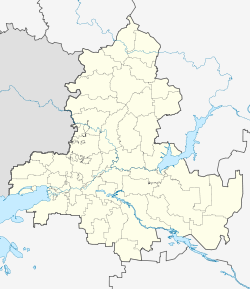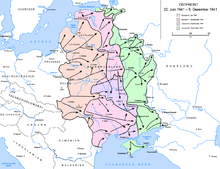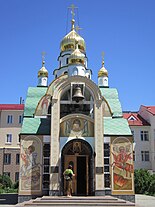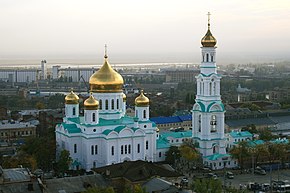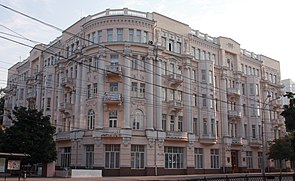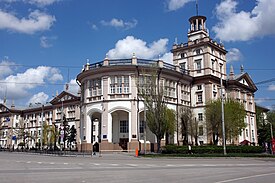Rostov on Don
| city
Rostov-on-Don
Ростов-на-Дону
|
|||||||||||||||||||||||||||||||||||||||||||||
|
|||||||||||||||||||||||||||||||||||||||||||||
|
|||||||||||||||||||||||||||||||||||||||||||||
| List of cities in Russia | |||||||||||||||||||||||||||||||||||||||||||||
Rostov-on-Don ( Russian Росто́в-на-Дону́ , Rostov-na-Donu ) is one of the largest cities in the European part of the Russian Federation . It is located in the south of the country, 46 kilometers from the mouth of the Don in the Sea of Azov . It is also the capital of the Rostov region and is known as the “gateway to the Caucasus ”.
With 1,115,000 inhabitants (2015), the city is the tenth largest city in Russia. Almost 2.16 million people live in the Rostov agglomeration. Rostov-on-Don is 960 kilometers south of Moscow . It forms the political, cultural and economic center of southern Russia.
geography
The city is located in the southeast of the Eastern European Plain , most of the districts are on the right bank of the Don, 46 km from its confluence with the Sea of Azov. The south-western districts border on the Don River Delta. The geographic location of the city not far from the Black, Azov and Caspian Seas and the canals that connect Rostov with the Baltic and White Seas have earned it the nickname “City of the Five Seas”.
climate
It is warmest in July . Average temperatures of +24 ° C are then reached. With an average of -4.2 ° C, January is the coldest month of the whole year.
| Rostov on Don | ||||||||||||||||||||||||||||||||||||||||||||||||
|---|---|---|---|---|---|---|---|---|---|---|---|---|---|---|---|---|---|---|---|---|---|---|---|---|---|---|---|---|---|---|---|---|---|---|---|---|---|---|---|---|---|---|---|---|---|---|---|---|
| Climate diagram | ||||||||||||||||||||||||||||||||||||||||||||||||
| ||||||||||||||||||||||||||||||||||||||||||||||||
|
Average monthly temperatures and rainfall for Rostov-on-Don
|
|||||||||||||||||||||||||||||||||||||||||||||||||||||||||||||||||||||||||||
structure
Historically, Rostov consists of two city centers, the actual Rostov and Nakhichevan , which was incorporated in 1920 , a former colony of Armenian exiles that is still home to a large Armenian community. Administratively, the city is divided into eight districts (Voroshilovsky, Schelesnodorozhny, Kirovsky, Leninsky, Oktyabrsky, Pervomaiski, Proletarsky and Sovetsky). These are not based on the historical borders of the two once independent cities. The most populous district is Voroshilovsky, which only emerged in the second half of the 20th century and is characterized by prefabricated housing estates. The real center is the Kirovsky and Leninsky districts. Most of the urban area is on the northern bank of the Don. The only district on the south bank, Zarechnaja, is characterized by port and industrial facilities.
The Rostov agglomeration with its almost 2.2 million inhabitants is more extensive and includes the cities of Azov , Aksai and Bataisk , among others . In front of Rostov lies the “Green Island” (Seljony Ostrow) in the Don, a forested island several square kilometers in size, which is used by the Rostov people as a recreational area.
history
The area around Rostov-on-Don was already settled in antiquity, around 30 kilometers west of the city limits was the Greek colony of Tanais . The region later became a Genoese colony and finally came under the Ottomans at the end of the 15th century , although the Zaporozhian Cossacks undertook frequent campaigns as far as the Sea of Azov. In the 18th century, after several wars with the Ottomans, Russia finally took control of the northern Black Sea region and the Caucasus.
Russia
A customs house and port have been located on the Rostov area since 1749. The place itself was founded in 1761 under Elizabeth Petrovna to protect Russian trade routes as a fortress settlement on the southern border of the empire. It was named after the Metropolitan Dimitri von Rostow . After Russia succeeded in displacing the Ottomans from the entire northern Black Sea region (Tbilisi Military District) in the 18th century, Rostov lost its military importance, became a major trading center and quickly overtook the nearby Azov . Rostov received city status in 1797 and has been a district town since then.
As a river port near the sea, Rostov-on-Don rose to become the most important trading center and transport hub in southern Russia in the 19th century. In the 19th century, the city was the administrative center of the Ujesd Rostov in the Yekaterinoslav governorate . Since 1887 Rostov belonged to the territory of the Don Army . Industrial development began in the middle of the 19th century. An iron foundry was built on the basis of Donbass coal and iron ores from Krivoy Rog in 1846 and in 1859 the production of steam boilers and pumps began. Railway connections to Kharkov (1871), Voronezh (1871) and Vladikavkaz (1875) were opened. The industrial boom was accompanied by a rapid increase in population, and by the end of the 19th century there were already around 140 industrial companies in the city. The port in southern Russia was one of the largest transshipment points, especially for the export of grain, iron ore and wood.
Historically, Rostov consists of two parts: Rostov and Nakhchivan. Nakhichevan was an independent city inhabited by Armenians who were moved here by Catherine II from the Caucasus in the 18th century. The former border between the two cities is Theaterplatz. Nakhchivan is home to a large Armenian community.
In the census of 1897 Rostov-on-Don had a population of 119,500, of which 79.2% Russians, 9.4% Jews, 4.7% Ukrainians, 1.9% Armenians and 1.0% Tatars. In the 1920s Rostov-on-Don rose to become the third largest city in Russia, with the previously independent neighboring city of Nakhichevan on the Don being incorporated. As a result of the incorporation, the proportion of Armenians in Rostov grew accordingly. In 1939 the city had more than 500,000 inhabitants.
After the dissolution of the Don Army area in 1920, Rostov was the capital of several changing administrative units in the early Soviet Union : from 1920 to 1924 the Don Oblast , 1924 the Southeast Oblast , 1924 to 1934 the North Caucasus Krai and from 1934 to 1937 the Azov-Black Sea Krai . In 1937 the existing Rostov Oblast was established.
Second World War

During the Second World War , the city was first attacked by the German III on November 20, 1941 in the Battle of Rostov . Army corps captured. However, the massive counterattack by the Red Army began just two days later . On November 28, the German troops, together with collaborating Cossacks, left Rostov-on-Don and retreated to Taganrog . As they retreated, they left a trail of devastation. Many factories and houses were destroyed and burned down by them. 200 Soviet prisoners of war were shot at the train station just a few hours before the city was liberated. Around 3,000 residents of the city were killed in air strikes and fighting during these eight days.
After the Red Army liberated the city, the reconstruction of the destroyed factories and houses began immediately. The basis was the assumption that the Germans would not be able to conquer the city again. However, on July 24, 1942, the city was defeated by the vanguard of XXXXIX. Mountain Corps and units of the 5th SS Panzer Division "Wiking" occupied for the second time.
The Jews living in Rostov had to meet on 11/12. Gathered in a school building on August 6 , 1942 and were herded to Smijowskaya Balka (Snake Gorge ), where they were shot . Among them were the then 56-year-old psychoanalyst Sabina Spielrein and her two daughters Renata and Eva as well as the 34-year-old poet Jelena Michailowna Schirmann and her parents.
After fierce fighting, the city was recaptured and finally liberated in February 1943. In the city there were three POW camps 251 , 421 and 475 for German POWs of the Second World War.
After the Second World War, the destruction was quickly removed and by the 1950s the population was already higher than before the war. At the end of the 1980s, Rostov became a city of millions.
Since 1991
With the collapse of the Soviet Union , industrial production declined sharply in the 1990s. At the end of the decade, Rostov-on-Don was replaced by Krasnodar as the largest industrial location in the North Caucasus . In 2001 the population fell below a million. A trend reversal has been observed since 2002. It is associated with a renewed increase in the number of inhabitants, partly due to the immigration of refugees from the ethnic crisis areas of the Caucasus, partly also due to a significant improvement in the economic situation since the early 2000s. Rostov can increasingly expand its function as a major international transport hub. In 2000, Rostov-on-Don was named the capital of the Southern Federal District.
On May 5, 2008, the city received the honorary title "City of Military Glory" from the President of the Russian Federation by ukase .
Rostov-on-Don hosted the 2018 World Cup in Russia.
Population and ethnicities
At the last census on October 14, 2010, 1,089,261 people lived in the city. In 2014 the population was given as 1,109,800. Almost 2.2 million people live in the agglomeration and around 2.7 million in the enlarged metropolitan area.
The vast majority of city dwellers consider themselves to be the Russians , but there are a large number of other ethnic groups in Rostov-on-Don. At the end of the 1980s, Rostov-on-Don became a city of millions. In addition to the Russians as the dominant ethnic group, the Armenian and Ukrainian communities are historically significant. Rostov was and is an important center of the Armenian diaspora. In the vicinity of Rostov is the small town of Chaltyr , which is mostly inhabited by Armenians. The proportion of Ukrainians in Rostov and the surrounding area was significantly higher in the 19th and early 20th centuries and has fallen sharply as a result of the long assimilation; it is less than 2% of the population. While only a few Ukrainians lived in Rostov itself at the beginning of the 20th century, in 1897 around a third of the population in the Rostov region were Ukrainians.
| nationality | number | percent |
|---|---|---|
| Russians | 960.883 | 90.1% |
| Armenians | 41,553 | 3.4% |
| Ukrainians | 16,249 | 1.5% |
| Azerbaijanis | 6,739 | 0.6% |
| Tatars | 5,299 | 0.5% |
| Georgians | 3,960 | 0.4% |
| Belarusians | 2,874 | 0.3% |
| Korean | 2,792 | 0.3% |
| Jews | 2,403 | 0.2% |
| Greed | 1,660 | 0.2% |
| Kyrgyz | 1,374 | 0.1% |
| Uzbeks | 1,188 | 0.1% |
| Chechens | 1,073 | 0.1% |
| Ossetians | 992 | 0.1% |
| Greeks | 950 | 0.1% |
| Ingush | 928 | 0.1% |
| Roma | 893 | 0.1% |
| Tajiks | 852 | 0.1% |
Boroughs (Rajony)
| No. | Rajon | Russian name | Area km² |
Residents |
|---|---|---|---|---|
| 1 | Voroshilovsky | Ворошиловский | 38.0 | 215,400 |
| 2 | Zheleznodorozhny | Железнодорожный | 69.0 | 102,200 |
| 3 | Kirowski | Кировский | 18.6 | 65,200 |
| 4th | Leninsky | Ленинский | 13.0 | 80,900 |
| 5 | Oktyabrsky | Октябрьский | 49.5 | 166.200 |
| 6th | Pervomaysky | Pervomaya | 44.1 | 182,100 |
| 7th | Proletarsky | Пролетарский | 37.1 | 119,800 |
| 8th | Sowetski | Советский | 85.4 | 178,000 |
Population development
| year | 1811 | 1897 | 1939 | 1959 | 1970 | 1979 | 1989 | 2002 | 2010 | 2011 | 2012 | 2013 | 2014 | 2015 |
|---|---|---|---|---|---|---|---|---|---|---|---|---|---|---|
| Residents | 4,000 | 119,500 | 502,928 * | 599,542 | 788.827 | 934.095 | 1,019,305 | 1,068,267 | 1,089,261 | 1,091,544 | 1,099,500 | 1,104,000 | 1,109,800 | 1,115,000 |
* and 7,284 workers' settlement Nizhne-Gnilowskoi (incorporated before 1959)
Religions
The dominant religion in Rostov-on-Don is Christianity . The largest Christian denomination in the city is the Russian Orthodox Church , which is represented by 41 churches and monasteries. Most of them were rebuilt or refurbished after 1990. There is also a Church of the Old Orthodox and a Greek Orthodox Church. There are three churches of the Armenian Apostolic Church , the Roman Catholic Last Supper Jesus Church , a prayer house for the Evangelical Christians and Baptists, and an Advent house for the Seventh-day Adventists .
In addition, there are several mosques , a synagogue and a Buddhist temple in Rostov-on-Don .
| Church of the Protection and Intercession of the Virgin Mary | Church of St. Dimitri | Church of St. George | Church of the Holy Martyr and Healer Panteleimon | Cathedral of the Nativity of the Holy Mother of God |
Economy and Infrastructure
The most important branches of industry in the city are the woodworking industry as well as radio-electronic, electrotechnical and chemical production. In addition, because of its fertile black soils , large quantities of agricultural products, especially grain, are produced in the Rostov region . The region is one of the most important coal mining areas in the Russian Federation . Rostov is also home to the headquarters of the largest Eastern European manufacturer of agricultural machinery, Rostselmasch . The Rostov nuclear power plant , which has been generating electricity since 2001, is located near the city of Volgodonsk .
traffic
Rostov-on-Don is a transport hub in southern Russia. There is a large train station there, which is the most important railway junction in the south, and an international airport , with its location on the river an important inland port on the Don. The city is the administrative seat of the North Caucasian Regional Directorate of the Russian State Railways . The directorate operates all railway lines and the associated infrastructure in the Rostov region, as well as a rail network over 6300 kilometers long.
Rostov-on-Don is connected to the Russian capital Moscow via the M4 Don highway and its approximately two-kilometer-long, four-lane feeder. At the same time, the city is the starting point of the A280 junction , which is part of the European route 58 and leads west to the Ukrainian border via Taganrog .
Attractions
Sights are the art gallery , the various large churches in the city center, including the cathedral built by Konstantin Thon , the music theater , the circus , the oblast museum and the public library.
In summer the banks of the Don invite you to take a stroll with its restaurants and piers. In the city is the Botanical Garden of the South Federal University .
Theaters, museums and concert halls are located on the four kilometer long main shopping street Bolshaya Sadowaja uliza . As part of the preparations for the 2018 World Cup, the Soborny pereulok , which connects Bolshaya Sadovaya Street with Rostov Cathedral, was partially redesigned into a pedestrian zone.
The part of the city on the north bank of the Don, in which there is a lot of historical building fabric, has been revitalized for several years . The Armenian Church of Gregory the Illuminator is located in the Nakhichevan district , next to which the Armenian consulate is located.
|
Further educational institutions

The city has four universities and numerous other colleges. The former largest university in the city was the Rostov State University (RGU), which was opened in 1915. In January 2007, the RGU merged with other Rostov and southern Russian universities to form JUFU, the Southern Federal University. With around 33,000 students, it is one of the largest universities in the country outside of Saint Petersburg and Moscow, as well as the State Technical University of the Don Region .
There are educational, economic and medical institutes in the city.
- Faculty of the State Academy of Waterways Transport of the Volga Region
- Branch of the Belgorod University of Consumer Cooperative
- Branch of the Moscow State Trade University
- Branch of the Moscow State Technical University of Civil Aviation
- Branch of the Moscow Telecommunications and Computer Science University of Technology
- Branch of the Russian Customs Academy
- Branch of the Saint Petersburg State Art Academy
- Branch of the Taganrog State University of Telecommunications
- Branch of the Institute for International Law and Economics
- Branch of the Moscow Institute of Entrepreneurship and Law
- Branch of the Moscow State Remote Food Industry Institute
- Free Russian-German Institute for Communication Rostov-on-Don, FRDIP
- Institute of Business and Law Rostov-on-Don
- Institute for International Business
- Institute for Administration, Business and Law
- Legal Institute of the Don Region
- North Caucasian Academy of Civil Service
- North Caucasian business institute
- North Caucasian Institute for Anthropology and Applied Sociology
- Rostov branch of the Novocherkassk State Technical University
- Rostov University of the Interior Ministry of Russia
- Rostov Institute for Automation and Mechanical Engineering
- Rostov Institute for Business and Law
- Rostov Institute of Business and Entrepreneurship
- Rostov Institute for Foreign Languages
- Rostov Legal Institute
- Rostov Military Institute for Missile Forces
- Rostov State Academy of Construction
- Rostov State Building University
- Rostov State Medical University
- Rostov State Economic University
- Rostov State Pedagogical University
- Rostov State University
- Rostov State University of Transportation
- Rostov State Architecture Institute
- Rostov State S. W. Rachmaninoff Conservatory
- State Agricultural University of the Don Region
- State Academy of Agricultural Engineering Rostov-on-Don
- State Technical University of the Don Region
- South Russian Humanities Institute
- South Federal University
- Center for International Technological Cooperation in Teaching and Science "Internauka"
| Rostov State University of Transportation | State Technical University of the Don Region | Institute for Administration, Business and Law |
Sports
The two football clubs FK Rostov ( Premjer-Liga ) and FK SKA Rostov are based in Rostov-on-Don. Rostov-on-Don was one of the venues for the 2018 World Cup in Russia. For this purpose, the new Rostov-Arena stadium with a capacity of 43,702 spectators was built, in which FK Rostov has played its home games since 2018. Previously, the club played in the 15,840-seat Olimp-2 stadium .
In the city there is a handball club of the Russian league, the GK Rostov-on-Don .
sons and daughters of the town
The most famous sons and daughters of the city include the composer Andrei Pashchenko , the actors Sinaida Reich and Alexander Kaidanowski , the mathematician Leonid Sedow , the chess player Savielly Tartakower , the secret agent Geworg Vardanyan , the pop singers Irina Allegrowa and Eva Rivas , the writer Mikael Nalbandjan and Vera Panowa , the painter Martiros Sarjan , the athlete Antonina Kriwoschapka (* 1987), the composer and violinist Efrem Zimbalist , the polar explorer Georgi Sedov or the physicists Jakow Frenkel and Juri Oganessjan .
The Nobel Prize winners Mikhail Scholokhov and Alexander Solzhenitsyn were not born in the city, but resided there for a long time .
Twin cities
Rostov-on-Don lists the following twin cities :
-
 Gera (Germany) since 1987
Gera (Germany) since 1987 -
 Dortmund (Germany)
Dortmund (Germany) -
 Moscow (Russia)
Moscow (Russia) -
 Donetsk (Ukraine)
Donetsk (Ukraine) -
 Odessa (Ukraine)
Odessa (Ukraine) -
 Lugansk (Ukraine)
Lugansk (Ukraine) -
 Homel (Belarus)
Homel (Belarus) -
 Yerevan (Armenia)
Yerevan (Armenia) -
 Antalya (Turkey)
Antalya (Turkey) -
 Cheongju (South Korea)
Cheongju (South Korea) -
 Glasgow (Scotland)
Glasgow (Scotland) -
 Kajaani (Finland)
Kajaani (Finland) -
 Le Mans (France)
Le Mans (France) -
 Mobile (USA)
Mobile (USA) -
 Pleven (Bulgaria)
Pleven (Bulgaria) -
 Volos (Greece)
Volos (Greece) -
 Toronto (Canada)
Toronto (Canada) -
 Oral (Kazakhstan)
Oral (Kazakhstan)
Diplomatic and consular missions
The diplomatic and consular representations listed below are located in Rostov-on-Don (the address in brackets).
-
 Armenian Consulate General (ul. 12 linija, 4)
Armenian Consulate General (ul. 12 linija, 4) -
 British Visa Center (ul.Socialisticheskaya, 74, ofis 1308)
British Visa Center (ul.Socialisticheskaya, 74, ofis 1308) -
 Bulgarian Visa Center
Bulgarian Visa Center -
 German Visa Center (since January 2013)
German Visa Center (since January 2013) -
 French Visa Center
French Visa Center -
 Greek Visa Center
Greek Visa Center -
 Israeli embassy
Israeli embassy -
 Croatian Visa Center (since June 17, 2013)
Croatian Visa Center (since June 17, 2013) -
 Maltese Visa Center
Maltese Visa Center -
 Dutch Visa Center (per. Semaschko, dom 117g)
Dutch Visa Center (per. Semaschko, dom 117g) -
 Austrian Visa Center
Austrian Visa Center -
 Polish Visa Center (since January 2013)
Polish Visa Center (since January 2013) -
 Romanian Consulate General (ul. 7 linija, 18/39)
Romanian Consulate General (ul. 7 linija, 18/39) -
 Swedish Visa Center
Swedish Visa Center -
 Slovak Honorary Consulate
Slovak Honorary Consulate -
 Spanish Visa Center
Spanish Visa Center -
 Honorary Consulate of South Korea (pr.Budennowskij, 7 etasch)
Honorary Consulate of South Korea (pr.Budennowskij, 7 etasch) -
 Representation of the Ministry of Foreign Affairs of the Russian Federation (ul.Pushkinskaya, 221)
Representation of the Ministry of Foreign Affairs of the Russian Federation (ul.Pushkinskaya, 221) -
 Ukrainian Consulate General (per. Khalturinskij, 28/40)
Ukrainian Consulate General (per. Khalturinskij, 28/40) -
 Department of the Hungarian Commercial Agency (pr.Brudennowskij 60, 11 etasch)
Department of the Hungarian Commercial Agency (pr.Brudennowskij 60, 11 etasch) -
 Belarusian embassy department
Belarusian embassy department
Web links
- grants.rsu.ru - historical building photographs
- www.rostov.ru - regional internet portal
- www.rostovmuseum.ru - Internet portal of the Rostov Oblast Museum of Local History
Individual evidence
- ↑ Itogi Vserossijskoj perepisi naselenija 2010 goda. Tom 1. Čislennostʹ i razmeščenie naselenija (Results of the All-Russian Census 2010. Volume 1. Number and distribution of the population). Tables 5 , pp. 12-209; 11 , pp. 312–979 (download from the website of the Federal Service for State Statistics of the Russian Federation)
- ↑ Численность населения в Ростове-на-Дону на 1 января 2015 год
- ↑ a b Ростовская агломерация. Существующее положение
- ↑ de.sputniknews.com ( Memento from December 22, 2015 in the Internet Archive )
- ↑ a b demoscope.ru
- ↑ www.gks.ru (PDF)
- ↑ Johannes Hürter. Hitler's military leaders: the German commanders in chief in the war against the Soviet Union in 1941/42. - Munich: Oldenbourg Wissenschaftsverlag, 2007, p. 309.
- ↑ Erich Maschke (ed.): On the history of the German prisoners of war of the Second World War. Verlag Ernst and Werner Gieseking, Bielefeld 1962–1977.
- ↑ Ростовстат. Численность городского и сельского населения на January 1, 2014 года
- ↑ Проект стратегии социально-экономического развития Ростовской области до 2020 года ( Memento from January 30, 2012 in the Internet Archive )
- ↑ January 1, 2014
- ↑ 2018 FIFA World Cup ™ in eleven venues. In: fifa.com. FIFA, September 29, 2012, accessed November 21, 2013 .
- ↑ Дипломатические представительства иностранных государств на территории ЮФО (Diplomatic missions in the Southern Federal District) ( Memento of 8 April 2010 at the Internet Archive accessed) on www.rostov.mid.ru on March 6, 2014




